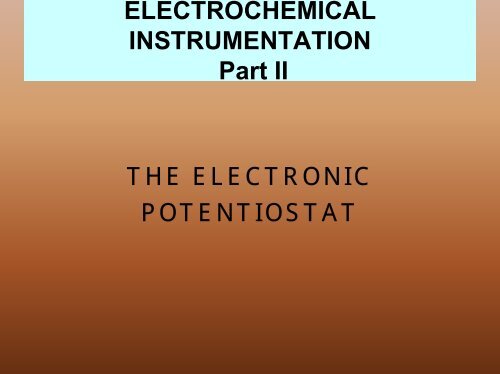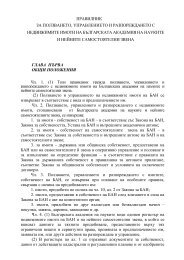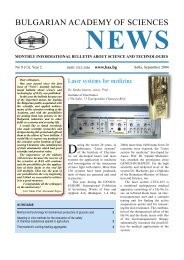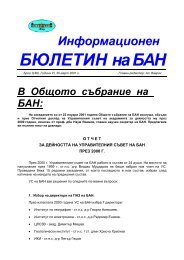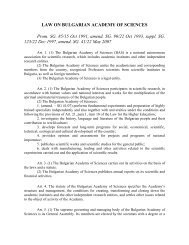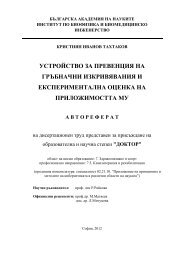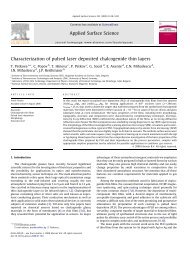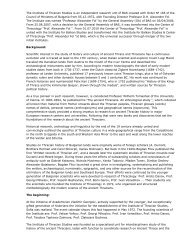The Potentiostat
The Potentiostat
The Potentiostat
- No tags were found...
Create successful ePaper yourself
Turn your PDF publications into a flip-book with our unique Google optimized e-Paper software.
ELECTROCHEMICALINSTRUMENTATIONPart IITHE ELECTRONICPOTENTIOSTAT
Basic Operational ModesDC and ACIref+ ∆ I.sin ( ωt- φ)IrefEref+ ∆ E.sin ωtEref
Short History• Complex numbers theory• Vector calculation theory• Steady state sinusoidal waves• Polar to rectangular and vice versa• <strong>The</strong> Laplace transform• Gain and phase• Logarithmic gain and phase• <strong>The</strong> OpAmp Bode Characteristics
Back to the Inverter, Follower and I/E ConverterUout=−R 2R 1UinUout = UinUoutIinR
•Means for Ir compensation should be provided for“true” potential controlElectronic <strong>Potentiostat</strong> - Electrochemical Cell<strong>The</strong> electronic potentiostat must control the potential atthe investigated electrode, measure the current at thatelectrode, supply enough power to the cell, operatewithout introducing neither static (DC) or dynamic (AC)errors through the spanning operating range.•<strong>The</strong> MAIN amplifier is to handle the power demand(compliance voltage and output current) for electrodeswith varying size and surface resistance that areimmersed in solutions with diverse conductivity•<strong>The</strong> BUFFER amplifier is to have extremely high,electrometer like, input impedance and close to zerobias current, since current passing through thereference electrode can disturb its chemical equilibriumand result in inaccurate potential control•<strong>The</strong> I/E CONVERTER (current follower) is referenced toground and should maintain the working electrode atvirtually zero (0) volts
Steady State Sinusoidal Signalf( t ) = A cos ( ω t + θ)
Methods of Representing SineWavesf( t ) =Fcos( ω t+θ )2πT = secondsω1 ωf = = cycles per secondT 2πω = 2πfradians per second<strong>The</strong> figure illustrates the rotatingphasor and its sinusoidal projection on thereal axis. <strong>The</strong> phasor is a vector of length|F| standing at an angle θ from the realaxis. When rotating at an angularfrequency ω, its projection on the real axisrepresents the cosine function.
Time and Frequency Domain•<strong>The</strong> full advantage of the phasors is realizedwhen they are expressed in algebraic form. <strong>The</strong>vector form is useful for visualization while thealgebraic form is preferable for computations.•<strong>The</strong> one-to-one correspondence between a twodimensionalvector, or phasor, and a complexnumber is given by the Euler’s formula.e± jθ= cosθ ± sinθorf(t) = F cos(ωo+θ)± jθF = F e = F cosθ ±F sinθTimeDomainFrequency Domain
<strong>The</strong> Unit Vector<strong>The</strong>unitvectore± jθ= cosθ ± sinθhasalengthof:cos2θ + sin2θ = 1If the vector has a length± jθF e = F cosθ ± F sinθofF ,
Polar and Rectangular FormsAny complex number can be expressed either in terms of itsMagnitude and Angle or in terms of its Projections on the two axes.<strong>The</strong> phasor shown in the Figure has a length of |F| and it stands atan angle of θ with respect to the real axis.POLAR FORMF = FF =Fre+jθ= F cosθ + j F sin θ =RECTANGULAR FORMjFiF〈θ
Polar-to-Rectangular and Vice Versa<strong>The</strong> conversion of a given phasor from polar torectangular form is completed by resolving thevector geometrically along the two axes:F=Fejθ=Fcosθ+FsinθFr=FcosθFi=Fsinθ<strong>The</strong> conversion of a given phasor from rectangular to polar form isaccomplished by applying the Pythagorus theorem to the righttriangle. <strong>The</strong> length of the phasor is :F =θ = tanF-12rFF+irF2iPhasor lengthPhasor angle
NOTES‣ <strong>The</strong> magnitude of the frequency domainphasor is the same as the amplitude ofthe sinusoid, and the phasor angle withrespect to the real axis is the phase angleof the sinusoid written in cosine form‣ All the time functions of a problem can betransformed to phasors in the frequencydomain‣ <strong>The</strong> problem is solved by complexalgebra in the frequency domain‣ If needed, the resulting vector istransformed back to the time domain
<strong>The</strong> Resistance Element
<strong>The</strong> Capacitance Element
<strong>The</strong> Inductance Element
<strong>The</strong> Laplace TransformConsider a function φ(t) of time t, that is zero for t < 0. ItsLaplace transform Φ(p) is defined to be:Φ(p) =∞∫0φ(t)e− pt dtwhere p = σ +jω, with both σ and being ω real. <strong>The</strong> variable “p”has the dimensions of frequency and is therefore termed the“complex frequency variable”. <strong>The</strong> equation transforms thefunction φ(t) into another function Φ(p) in the complexfrequency domain. <strong>The</strong> two functions are said to constitute aLaplace Transform Pair. <strong>The</strong> transform pairs are commonlypresented in tables. <strong>The</strong> exponential factor e -pt assuresconvergence of the integral when applied to functions of timemost commonly met in the study of electrical systems.
An Exemplary Laplace Transform Pairs Table
Virtues of the Laplace Transform• <strong>The</strong> transient response of a linear circuit can bestudied by using the classical method of solvingordinary integro-differential equations• <strong>The</strong> Laplace transform converts the problem fromthe time domain to the complex frequency domain,where the transform of the solution can be obtainedby simple algebraic means. Next byapplying the inverse Laplace transform, the desiredsolution as a function of time can be obtained• Moreover the Laplace transformation enables theunification of the transient and frequency responsesof a given network; for the steady statesinusoidal signals p = jω
<strong>The</strong> RC Network ExampleG(p) =τ0=RC1pC1R+pC=11+pτ0
Gain-Phase Characteristics of an RC Network( )G jω( )G jωΦ = − tan1=1+pτ=−11+((01ωω01=jω1+ωωω)0)20
Logarithmic Gain-PhaseIn many cases it is more convenient to plot the frequency behavior of a responsefunction in logarithmic form rather than in the original form. <strong>The</strong> logarithmic plotis just another way of presenting the data, but it does have the advantage ofcompressing the dynamic range of the data, thereby making it fit better on a sheetof paper. <strong>The</strong> logarithm of a complex quantity is the complex number with a realpart equal to the logarithm of the complex quantity and an imaginary part equal tothe angle of the complex quantity. <strong>The</strong> natural logarithm of a given function G(jω)equalsG(jω) = A’(ω) + jΦ(ω), whereA’(ω) = ln |G(jω)| [neper]<strong>The</strong> function A’(ω), which is the natural logarithm of the magnitude function |G(jω)|is termed the logarithmic gain of the network and its measuring unit is the neper.Alternatively the gain can be expressed in decibels, abbreviated as dB; thusOne neper is equal to 8.69 decibels (dB).A(ω) = 20log|G(jω)| [dB]
Logarithmic Gain-Phase Characteristics of anRC Network)ωω(tanΦ)ωω(11G(jωjωjω11pτ11G(jωj012000−= −+=+=+=020000120ωω20logωω10log)1ωωWhen010log1)1ωωWhen)ωω(tanΦωω110log)= −⎟⎟⎠⎞⎜⎜⎝⎛≅ −⇒=≅ −⇒= −⎥⎥⎦⎤⎢⎢⎣⎡⎟⎟⎠⎞⎜⎜⎝⎛+= −−A(ωA(ωA(ωffpp
)log()()()(ooooAdBAAωωωωωωωωωωω2013101≈−〉〉≈=≈〈〈00090145101≈−〉〉−==≈〈〈)()()(ωΦωωωΦωωωΦωωoooΦLOGARITHMICPLOTS OF THE GAIN(ATTENUATION)AND PHASE OF ARC NETWORK
Typical OpAmp Circuit
<strong>The</strong> Operational Amplifier Gain/PhaseLetThanτof( )A pA 1, A 2, A 31, τA( ω)Thisthethewhere, τaddition1= A 11 + pτ2[ dB ] = 20 log A( p)22⎡ ⎛ ω ⎞ ⎤ ⎡ ⎛ ω ⎞ ⎤ ⎡ ⎛ ω− 10 log ⎢1+⎜ 10 log 110 log 1ω⎟ ⎥ − ⎢ +⎜ ⎥ − ⎢ +1ω⎟⎜⎢⎢ 2 ⎥ ⎢ ω3⎣ ⎝ ⎠ ⎥⎦⎣ ⎝ ⎠ ⎦ ⎣ ⎝<strong>The</strong> phase angle is the sum of the phase anglesisits3typicalareindividualyetcomplexarethethetimeanotherOpAmp1gain1A 21 + pτstagesvirtuethe multiplica tion(substract ion)havewill2DC gains, andconstants1A 31 + pτofbethreethe(division)stages .3, where= 20 logA 1 + 20 logA 2 + 20 logA 3logarithmi c presentati on,transformsto⎞⎟⎠2⎤⎥⎥⎦
Classical Feedback <strong>The</strong>oryTwo distinct cases:1. G CL = 1/β, when βA is too largeIn this case the system closedloop gain G is defined entirelyby the negative feedbackcomponents and the outputsignal is precisely defined by“β”.GCLUl A= =Uin 1+βAWhen βA→∞When βA=1〈180degGGCLCL1⇒β⇒∞2. G CL= infinity, when βA = -1In this case the system istotally useless, loses control,the closed loop gain G goesto infinity and the outputbecomes destructive.
Unstable/Stable Two Pole OpAmp<strong>The</strong> phase shift around the feedback loopshould not reach 360 0 at a frequency for whichthe loop gain βA is unity since the feedbackbecomes effectively positive, the fed backsignal reinforces the input signal and thesystem starts self oscillating at thatfrequency. <strong>The</strong> negative feedbackproduces a stabilizing 180 0 phase shift, but anadditional 180 0 can be developed within theamplifier or the feedback network to induceoscillations. In other words oscillations wouldoccur whenA(p).β(p) = 1
Phase Stabilized OpAmp<strong>The</strong> routine practice for phasestabilization of a general purposeOpAmp is to purposefully add a lowerfrequency dominating pole whichshapes the overall response to asecure 45 0 phase shift margin,excluding frequency responsepeaking as well as transient responseovershoot and ringing.<strong>The</strong> effect of such phase stabilizationis illustrated in the figure togetherwith the noticeable gain and phasereduction at high frequencies.In other words all techniques aimingto enhance a control system stabilityinevitably deteriorate the overallsystem dynamic properties resultingto impaired frequency response.
Typical OpAmp AC Plots•<strong>The</strong> corner frequency, ω c , (the -3dBpoint), of the closed loop gain is givenby the intersection of the A(jω) and 1/βcurves•<strong>The</strong> open loop unity gain bandwidth,at ω c , is related to the closed loopbandwidth, ω o , by ω c = ω 0 /β• At low frequency (where the loopgain βA is high) the closed loop gain isdetermined by the feedback network –if βA=100 (40dB), the closed loop erroris 1%•At high frequencies the closed loopgain approaches the open loop gain –the dynamic (vector) error increasessignificantly and the ACmeasurements at high frequenciesbecome progressively useless
<strong>The</strong> Electronic <strong>Potentiostat</strong>Historical Background• Hickling (1942) – Active potential control• Hodgkin (1952) – Enhanced potentiostat• Wenking (1956) – Single pole system• Booman (1957) – Op Amp potentiostat
<strong>The</strong> Electronic <strong>Potentiostat</strong>(Power Arrangement)Eref + ∆ E sinωtRelrZdlIref+ ∆I sin( ωt- φ)RsEl•<strong>The</strong> fundamental aim is toinvestigate the relation betweenthe controlled potential of thestudied electrode and thecurrent flowing through it (orvice versa when the galvanostatfunction is in force)•<strong>The</strong> electronic amplifier acts asa voltage source applied to thecounter electrode CE•<strong>The</strong> negative feedback signaldeveloped at the referenceelectrode RE is fed back to theamplifier input through β N•<strong>The</strong> proportional to the cellcurrent positive feedback signalfor Ir compensation is fed backto the amplifier input through β P•<strong>The</strong> Eref is the reference source
<strong>The</strong> Power <strong>Potentiostat</strong> Circuit Diagram
<strong>The</strong> I/E Converter <strong>Potentiostat</strong>
<strong>The</strong> Transfer FunctionDepending on the r/R4 ratio the transferfunction of the electronic potentiostathas some important properties:rff1⇒ No feedbackR 4Ul(f = 0)= − Uin(f = 0)⇒Uesignal(f = 0)forIrRdl= − Uinr+Rdlcompensation1 r + Rdl 1 1+ pτ′′AUl3 Re l+ r+ Rdl 1 + pτ0 1 + pτ′Gcl ( p)=− =Ui r+Rdl 1 1 + pτ′′ 1 r− R4 + Rdl 1+pτe1 + ARe l + r + Rdl 1 + pτ1 + pτ′ 3 r+Rdl 1 + pτ′′0rR 4Ul= 1 ⇒100% feedback(f = 0)= − Uin(f = 0)r+Rdl⇒RdlsignalUefor(f = 0)Ir= − Uincompensation(Re l+r)Rdlτ ′=Re l + r + Rdl CdlrRdlτ ′′ =r + Rdl Cdlτ = ( r − R4)Rdler − R4+ Rdl Cdlτ o⇒ OA1τ ′ ≈ Re lCdlτ ′′ ≈ rCdl0 ≤ τ ≤ τ ′′erR 4Ul= 0.9 ⇒90% feedback(f = 0)= − Uin(f = 0)signal0.9r+Rdl⇒RdlUefor(f = 0)Ircompensation≈ − Uin
Gain-Phase Characteristics WithoutPositive Ir CompensationARdlRe l + RdlIn the case of zero Ir compensation theelectrochemically modified open loopgain of the main amplifier OA1 isvirtually shaped by the cell electricalequivalent components.<strong>The</strong> frequency response of the systemis slightly reduced as is the gain at zerofrequency.<strong>The</strong> feedback control system remainshowever absolutely stable since thepoint of intersect N occurs at a 90 0phase shift.
Gain-Phase with 100% Ir CompensationA [dB]r + RdlAoRe l + r + Rdlr + Rdl3R d lΦ 011 + pτο1 + pτ′′1+ pτ′1+pτ e1 + pτ′′In an attempt to perfectly cancel out the DC“Ir” error caused by the final valued residual“r” due to the small, but physically present,distance between the Luggin capillaryreference electrode and the investigatedelectrode, the experimenter aims to arrive atthe best possible DC precision byintentionally applying positive feedbackcounteracting the error “Ir” term. This acthowever reshapes the feedback red line insuch an way that the point of intercept Noccurs at a phase angle of 180 0 whichbrings the feedback control system on theverge of stability and in reality the systemloses control breaking into wild oscillationsand destroying any delicate electrochemicalload. In other words the electronicpotentiostat is possibly one of the fewelectronic control systems where DCprecision is directly related to AC stability.
Gain-Phase with 90 % Ir CompensationA [dB]r+ Rs+RdlAoRe l + r + Rs + Rdlr + Rdl3r − 0 .9 r + Rdl11 + pτ1 + pτ eο1+ pτ′′1 + pτ′′1 + pτ′fer3r − 0 .9 rfo fc ' fc '' ftΦ 0Compromising DC accuracy against ACstability one can achieve somesatisfactory results by applying partialpositive “Ir” compensating feedback. <strong>The</strong>limit in the illustrated figure is set to 90%Ir compensation, the Ir drop is canceledout to a 10% error term, but the criticalpoint of intersect N has been moved to anew position where the phase angle ismuch safer (close to 90 0 in this particularcase) and the control system stability issecurely preserved.This approach of partial Ir compensationis commonly adapted in theelectrochemical experimenter practicesince the inferior DC accuracy is greatlyoffset by the risk of utilizing a potentiallyuseless, unstable and destructive system.
Gain-Phase Repositionwith 0 to 100 % Ir Compensationr+RdlAoRel + r + Rdl11+pτο1 + pτ′′1 + pτ′r3r−R4r+Rdl3r − R4+ Rdl1+ pτ′1 +pτefo fc ' fc '' ftThis figure is an illustration of the phaseshift change with decreasing positivefeedback for Ir compensation. <strong>The</strong> phaseshift progressively reduces when the Ircompensation is minimized from up to100%, down to 99%, down to 90%, andfinally down to no positive feedback at all –zero Ir compensation.
Fast <strong>Potentiostat</strong> with Ir Compensation
Frequency Dependent Transfer Functionof the Fast <strong>Potentiostat</strong>
Low and High FrequencyDemand on Gain at 100% Ir CompensationUe = UiG = r+ZZUe = Uir RG( f ⇒ 0)= +RUe = UirG f ⇒∞ = + 0( ) =∞0<strong>The</strong> aim is to maintain Ue=Ui, hencethe residual “r” participation shouldbe overcome by intentionally liftingthe gain G.At zero frequency the gain maytheoretically be lifted since thecapacitive component has aninfinite value (however thesystem will in practice lose control).At high frequencies the capacitivecomponent effectively becomes“short circuit” and the gain goes toinfinity, which is just another way ofexplaining the system instability.
<strong>The</strong> Fast <strong>Potentiostat</strong> Gain-Phaseat 90% Ir Compensation
Phase Stabilization Techniques
Co Phase StabilizationRs+RdlAoRel + Rs + RdlRs( 1 − Kd ) + Rdl3Rdl1 11+ pτο 1 + pτ′In some cases the electrochemicalexperiment may not include any residual“r” at all (mercury pool). In suchinstances the electronic potentiostat willbe loaded by a purely capacitive loadthat appends an additional pole to theamplifier open loop frequency dependentgain. This necessitates the application ofsome kind of system stabilization aimedat the phase reduction at the criticalpoint of intersect N.<strong>The</strong> figure illustrates the most common“Co” addition which repositions thecritical point to a new location, N1, wherethe phase shift is much safer.
R-Z Phase StabilizationRs+RdlAoRel + Rs + RdlRs( 1− Kd ) + Rdl3Rdl1 11+ pτο 1 + pτ′An analogous result may be achieved byusing either an additional resistor R atthe amplifier input, which however willraise the amplifier offset voltage andnoise, or a supplementary impedance Z,that will dynamically stabilize the systemby lifting the red feedback line toreposition the critical point of intersectN1 to a safer phase shift.Both approaches inevitably reduce thefrequency response of the completesystem – an act which is considerablyoffset by the enhanced system stability,reduced frequency response peakingand transient response overshoot andringing.
Low Pass Filter Phase Stabilizationr+ Rs+RdlAoRe l + r+ Rs+Rdlr+ Rs + Rdl3Rdl11 + pτο1+ pτ′′1 + pτ′1+ pτ ′′A promising technique for phasestabilization is to dynamicallycounteract the destabilizing Ircompensation effect by purposefullyadding a Low Pass filter within thepositive feedback loop. <strong>The</strong>descriptive figure illustrates an exactcoincidence of the Ir and LP breakfrequencies, which purpose howeveris to only demonstrate the LP filterstabilizing effect that brings thecritical N1 intersect to a much saferphase shift. It should be noted that ahigher frequency LP break frequencywould lead to a correspondingly lessinfluential stabilization effect – muchsimilar to the 99%,90%,50%, 10% Ircompensation.
<strong>The</strong> Solartron 1286 Circuit Diagram
<strong>The</strong> Solartron 1286 <strong>Potentiostat</strong>
<strong>The</strong> EG&G 273A <strong>Potentiostat</strong>
<strong>The</strong> PAR 173 <strong>Potentiostat</strong>
<strong>The</strong> Digital Transfer Function Analyzer(Correlation Principle)x(t) = Xo sin ωtReT∫0S(t) = XoKReIm1TWhen( lim T→∞)S(t) sin ωt dtthe( lim T→∞) = ∫jφ(ω)CELL transfer function is K( ω) e( ω) sin [ ωt + φ( ω)] + Am sin ( mωt− φ )=1T1TT∫0T0Im1TT∫0S(t) cos ωt dt∑mS(t) sin ωt dt = Xo K( ω)cosφ(ω)S(t) cos ωt dt = Xo K( ω)sinφ(ω)n+ n(t)
<strong>The</strong> Solartron 1250 Transfer FunctionAnalyzer
<strong>The</strong> Solartron 1260 Impedance Analyzer
An Advanced <strong>Potentiostat</strong>ic/GalvanostaticSystem/FRA – PAR Model 2263
<strong>The</strong> “Two-in-One” InstrumentFAST PATHPOWER PATH


